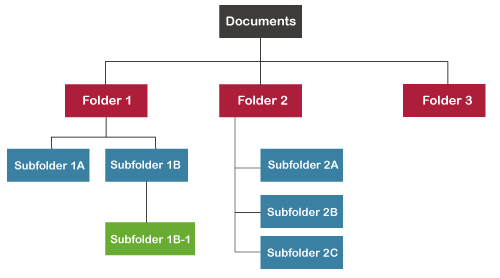Organize Documents Folder

Organizing your Documents folder is essential for efficient file management and easy access to information. Here are some tips on how to organize your Documents folder:
1. Create Folders:
- By Project or Client: If you work on multiple projects or with different clients, create folders for each project or client. This helps keep related documents together.
- By Category or Topic: Organize documents by category or topic, such as "Work," "Personal," or "Financial."
2. Use Subfolders:
- Nested Folders: Within main folders, create subfolders for further organization. For instance, within a "Work" folder, you might have subfolders for "Reports," "Presentations," and "Meeting Notes."
3. Date-Based Organization:
- Year/Month/Day Structure: For time-sensitive documents, consider organizing them by date. Create folders with a structure like "Year/Month/Day" for easy chronological access.
4. Archive Old Documents:
- Yearly or Quarterly Archives: Move outdated or less frequently accessed files to an archive folder. This prevents your main folders from becoming cluttered while keeping important files accessible.
5. Use Descriptive Filenames:
- Clear and Consistent Naming: Give your documents descriptive, yet concise names. Include dates or version numbers if necessary. Consistent naming conventions make it easier to search for files.
6. Tagging or Labeling:
- Add Tags: Some operating systems allow you to add tags or labels to files. Use tags for additional categorization and quick identification.
7. Cloud Storage:
- Consider Cloud-Based Solutions: If you use cloud storage services like Dropbox, Google Drive, or OneDrive, take advantage of their organizational features. These services often allow you to tag, star, or favorite files, making them easy to find.
8. Regular Cleanup:
- Delete Unnecessary Files: Periodically review your Documents folder and delete files you no longer need. This helps maintain a clutter-free environment.
9. Back Up Important Documents:
- Regular Backups: Ensure that important documents are regularly backed up. This could be done using an external hard drive, cloud storage, or a dedicated backup service.
10. Use Desktop Shortcuts Sparingly:
- Avoid Clutter: While desktop shortcuts can provide quick access to files, too many can clutter your desktop. Reserve it for essential files or shortcuts.
11. Search and Indexing:
- Leverage Search Features: Use the search functionality provided by your operating system to quickly locate files. Ensure that your files are indexed for faster searches.
12. Consistent Maintenance:
- Regularly Review and Adjust: As your projects and needs evolve, revisit your folder structure periodically and make adjustments accordingly.
Organizing your Documents folder is a personal process, and the above suggestions can be adapted to suit your specific needs and workflow. The goal is to create a system that makes it easy to find and manage your documents efficiently.
Thank you.
